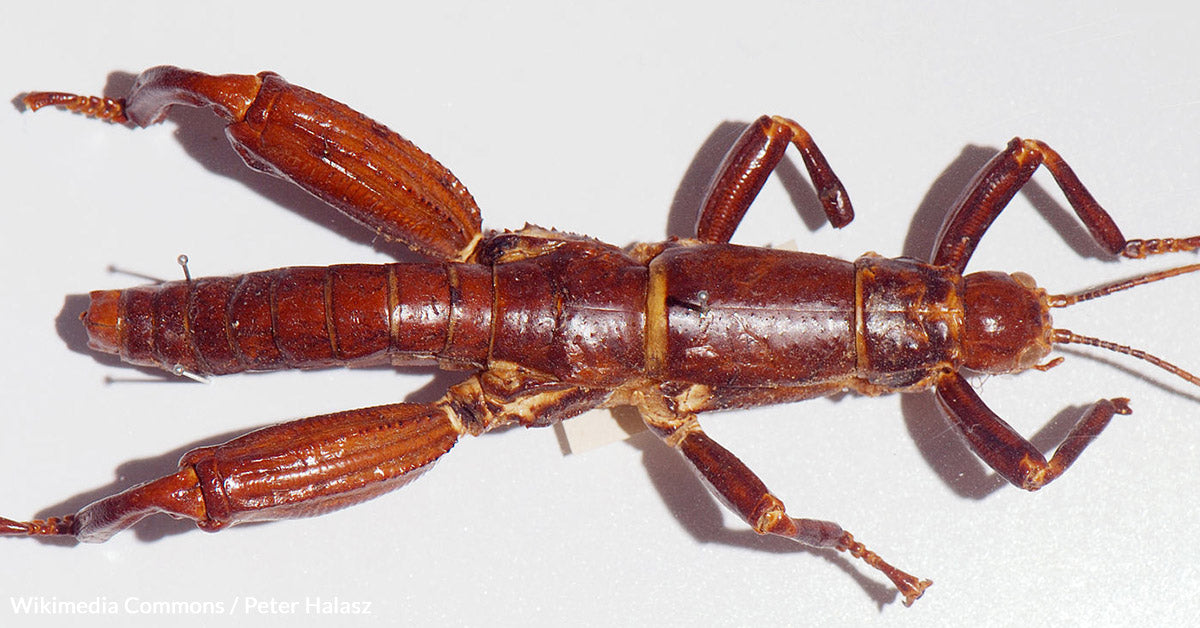Reviving the World's Rarest Insect is a Battle Against Odds for the Tree Lobster
Matthew Russell
Wikimedia Commons / Granitethighs
The Lord Howe Island Stick Insect, commonly known as the 'tree lobster', is writing a remarkable story of survival and resurgence. Once abundant on Lord Howe Island, off the east coast of Australia, these insects faced near-extinction due to a rat invasion in 1918.
Declared extinct in 1986, their rediscovery in 2001 on Ball's Pyramid has sparked a global conservation effort, reports Science Alert, resulting in a dramatic turnaround for this critically endangered species.
 Photo: Lord Howe Island stick insect Pengo, Wikimedia Commons / Melbourne Museum, License: CC BY-SA 3.0 DEED
Photo: Lord Howe Island stick insect Pengo, Wikimedia Commons / Melbourne Museum, License: CC BY-SA 3.0 DEEDThe "tree lobster" is the common name for the Lord Howe Island stick insect.
The Edge of Extinction
The 'tree lobster' is not just any insect. It's a large, flightless, nocturnal species, capable of growing as long as an adult human's hand. As the San Diego Zoo reports, their life begins as bright green nymphs, which gradually darken to a glossy brown-black as adults. These phasmids were once so common that fishermen used them as bait.
By the early 21st century, only 20 to 30 'tree lobsters' remained in the wild, clinging to existence on Ball's Pyramid, a near-vertical volcanic outcrop prone to catastrophic weather events and landslides, WION reports. Their survival was further threatened by an invasive vine strangling their sole food plant, Melaleuca howeana. However, in 2003, a pivotal moment occurred: a rescue team safely extracted four individuals to begin a breeding program, NPR reports.
 Photo: Dryococelus australis 02b Pengo, Wikimedia Commons / Peter Halasz, License: CC BY-SA 3.0 DEED
Photo: Dryococelus australis 02b Pengo, Wikimedia Commons / Peter Halasz, License: CC BY-SA 3.0 DEEDScientifically known as Dryococelus australis, it's a large, flightless insect.
Captive Breeding: A Beacon of Hope
Zoos worldwide, including Melbourne, Bristol, and San Diego, have played a crucial role in saving the 'tree lobster'. As Island Conservation reports, their collaborative efforts have resulted in thriving captive populations, now numbering in the thousands. This success story is a testament to the power of global conservation collaboration.
Parthenogenesis: Nature's Remarkable Reproductive Strategy
The survival of the 'tree lobster', despite critically low numbers, is partly due to the female's ability to clone themselves through parthenogenetic reproduction, reports National Geographic. This unique reproductive strategy has significantly contributed to the rapid increase in their population under captivity.
 Photo: Lord Howe Island stick insect Dryococelus australis 10June2011 PalmNursery, Wikimedia Commons / Granitethighs, License: CC BY-SA 3.0 DEED
Photo: Lord Howe Island stick insect Dryococelus australis 10June2011 PalmNursery, Wikimedia Commons / Granitethighs, License: CC BY-SA 3.0 DEEDZoos in Melbourne, Bristol, and San Diego have successfully bred thousands of tree lobsters in captivity.
Return to Lord Howe Island
Since 2019, efforts to eliminate rats on Lord Howe Island, aided by rat-detecting dogs, have led to an ecological renaissance, WION reports. The resurgence of unique wildlife, including endangered snails and the flightless Lord Howe Woodhen, are proof of the positive impact of these efforts. The zoos hope to reintroduce the 'tree lobster' back to Lord Howe Island, restoring a vital part of its ecosystem.
"What is unfolding is an ecological renaissance," Lord Howe Island resident Hank Bower told The Sydney Morning Herald.
 Photo: Wikimedia Commons / Image Science & Analysis Laboratory, NASA Johnson Space Center, License: Public Domain
Photo: Wikimedia Commons / Image Science & Analysis Laboratory, NASA Johnson Space Center, License: Public DomainIn 2001, a small population was rediscovered on Ball's Pyramid.
A Future for the 'Tree Lobster'
The story of the Lord Howe Island Stick Insect is one of hope, perseverance, and the power of concerted conservation efforts. As these insects thrive in captive breeding programs, the dream of reintroducing them into their natural habitat grows closer to reality.
This journey from the brink of extinction to a hopeful future is a powerful reminder of our ability to positively impact the natural world. Click below and take action for insects!
Matthew Russell is a West Michigan native and with a background in journalism, data analysis, cartography and design thinking. He likes to learn new things and solve old problems whenever possible, and enjoys bicycling, spending time with his daughters, and coffee.
